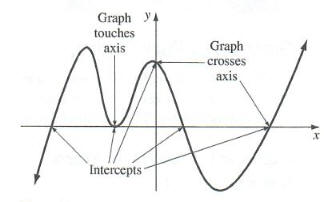Variables
GRAPHING EQUATIONS
OBJECTIVES
- Graphing Equations
- Graph Equations by Point-Plotting
- Determine Intercepts and Symmetry of a Graph
- Graph Equations Using Graphing Calculators
- Solve Problems Using Graphs
As we have already seen, illustrations such as scatterplots and lines of best
tit play an important role in helping us investigate the relationship between
two quantities. In the case where the relationship between two quantities is
described by a two- variable equation, it is often desirable to represent this
relationship geometrically with a graph. We restate a definition from earlier.
Graph of an Equation
The graph of an equation in the variables x and y consists of all points in
the zy-plane whose coordinates (x, y) satisfy the equation.
Graphing by Point-Plotting
A common technique for obtaining a sketch of the graph of an equation in two
vari ables is to first plot several points that lie on the graph and then
connect the points with a smooth curve. This is called, naturally,
point-plotting.
EXAMPLE 1
Graphing an Equation by Plotting Points
Sketch the graph of y = x^2
Solution
Since the given equation clearly shows how values of y are related to values
of x, it seems reasonable to start by assigning several different numbers to x
and then find the corresponding values of y to get points that lie on the graph.
We then plot these points and connect them with a smooth curve. See Figure l.

Notice that the sketch doesn't show all points on the graph, but it does
establish a continuing pattern. If a sketch of the graph of an equation shows
enough of the graph so that the viewer is able to "see" the rest of the graph as
a continuation of an established pattern, we often call the sketch complete. So,
when seeking such a sketch, one approach that might be taken is to plot a
sufficient number of points so that a pattern becomes evident and then connect
the points by a smooth curve. However, it is not always clear how many points
are sufficient. Some knowledge about the given equation and what characteristics
to expect the graph of the equation to have is certainly helpful. For instance,
we know that the graph of any equation of
the form y = mx +b is a straight line. Often a graphing utility can be very
helpful as it has the ability to plot points very rapidly and in large quantity.
For now, we will investigate some properties of the graph of an equation that
can be obtained from an algebraic analysis of the equation. Later, we will
return to the idea of using a graphing utility to obtain a sketch of the graph
of an equation.
Intercepts and Symmetry
The points, if any, where a graph touches or crosses one of the coordinate
axes are called intercepts. The x-coordinate of a point where a graph touches or
crosses the x-axis is called an x-intercept Similarly, the y-coordinate of a
point where a graph touches or crosses the y-axis is called a y-intercept, See
Figure 2.

EXAMPLE 2
Finding Intercepts - Identify the x- and y-intercepts for the graph given in
Figure 3.

Solution From the graph, we see that there are two y-intercepts: - 3 and 4.
Similarly. there are three x-intercepts: - 3, 1, and 4.
The intercepts of the graph of an equation can often be located algebraically by
using the fact that points on the x-axis have y-coordinates of zero and points
on the y-axis have x-coordinates of zero.